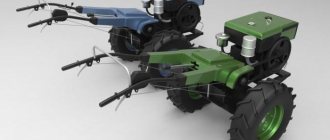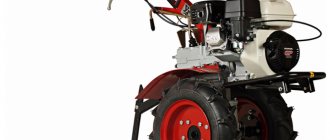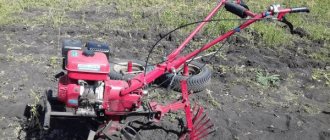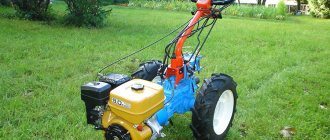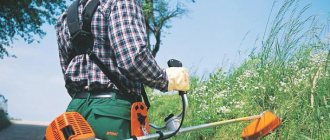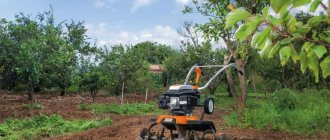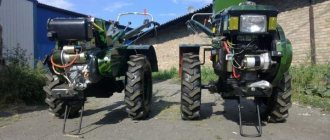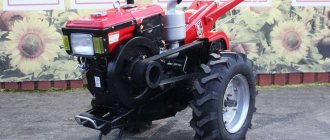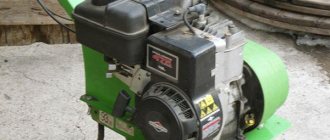15.11.2019
In fact, the topic is quite relevant and requires a thorough analysis. I decided to share my knowledge with you and explain on what principle you should choose a walk-behind tractor, since this thing, despite the saturation of the market, is quite individual.
What is the difference between a walk-behind tractor and a cultivator?
A cultivator is a power unit designed for cultivating soil with cutters. Soil cultivation is one of the most difficult and important work on the cultivated area. Previously, we took a shovel in our hands and dug up the ground, then we formed beds and planted various crops on them. Then walk-behind tractors appeared in the USSR, however, they turned out to be too heavy and bulky, and the price was quite high. Therefore, it was decided to reduce the cost of the design, throw out everything unnecessary: wheels, power take-off system, replace the frame and create a machine that would be more compact, more maneuverable, lighter and perform the most important task - cultivating the soil. The main elements of a cultivator: frame (not always), gearbox, engine, clutch. Moreover, as a rule, cultivators were equipped with a worm gearbox, on which it was impossible even to use a plow, otherwise the gearbox would simply fall apart. However, time has moved forward and today we are in the 21st century. The factories that worked in the USSR remained committed to the same ideas and concepts; the cultivator should be compact, lightweight and inexpensive. At its core, it must satisfy the requirements of a consumer with a summer cottage plot of up to 6 acres, where no more than 4-5 acres of land are cultivated.
PJSC "Kadvi" produces the Sadovnik TT motor-cultivator and the "Avangard" AMB-1M5.
JSC "Red October" motor cultivators of the MK70, MK80, MK100R, MK200 series
Gagarin Machine-Building Plant – Mobile K MKM
produces motor cultivators of the MK series
These are professional machines with a power of 5.5-6.5 hp, with high-quality gearboxes, weighing from 35 to 65 kg. and are configured in such a way that your arms and back do not suffer while working. As a rule, to minimize cost, they come without wheels.
However, Chinese technology, which has poured not only into the Belarusian market, but also into the markets of Russia and Ukraine, has made its own certain adjustments.
And this is where the CONFUSION began.
Cultivators with wheels began to be brought to the market and this equipment was called a walk-behind tractor. The mass of such units is 120-170 kg, an unnamed engine with a power of 10-18.5 hp, huge wheels, while the quality of gearboxes, powder metal and other elements leaves much to be desired. However, beautiful pictures and powerful technical characteristics urged the consumer to give money for a cultivator with the name of a walk-behind tractor, weighing 150 kg, which is completely non-functional and makes no sense. A Chinese cultivator is very easy to distinguish from a high-quality walk-behind tractor - the axles in Chinese technology are hexagonal, while in industrial-scale walk-behind tractors they are round. Why did Chinese cultivators switch to hexagonal ones? Because the massive wheels + heavy weight of the walk-behind tractor bent the round axles, they had to change the design and introduce a hexagon. As a result, the problem was solved, but with the condition that the equipment would work under gentle conditions. Within a year or two, gearboxes begin to crack, the frame, if of course it is present (sometimes all elements are attached to the gearbox, which in turn leads to constant vibrations and destruction of the gearbox, which is already of dubious quality), begins to crumble due to the powder that is used . In general, behind the beautiful photographs and inflated technical characteristics, there is nothing more behind these cultivators. Vivid examples of such manufacturers are: Asilak, Stark, Shtenli, Fermer.
Logic: and so, you need to find a logical explanation for where and how this or that cultivator can be used. While we are not talking about walk-behind tractors. Only about the cultivator.
1. If you have 4-6 acres of land cultivation, you are only interested in working with cutters, you need to take high-quality, lightweight, well-designed and reliable cultivators.
Advantages: no load on the back, ideal balancing for working with cutters, high-quality components, branded engines, low price. Almost any cultivator can be equipped with lugs and work with a plow or hiller.
Disadvantages: you cannot transport loads, you cannot use active attachments (mowers, planters, diggers, wood splitters, bush crushers, feed crushers, etc.)
2. If you have a plot of 6-20 acres. Your tasks are also limited to working with cutters, a plow, a hiller, you can consider Chinese-made cultivators with a large mass.
Advantages: high weight, large cutter grip, can be used with a trailer for transporting goods.
Disadvantages: very low quality (formally, buying such a cultivator will allow you to work for 2-3 years, after which it will actually fall apart), very high price (the cost of a cultivator ranges from 900 to 2000 rubles, for that amount you can get a high-quality walk-behind tractor), not maintainable , it is impossible to use active attachments (mowers, planters, diggers, wood splitters, bush crushers, feed crushers, etc.)
CONCLUSION : no matter what kind of cultivator you look at, domestic or Chinese, heavy or light, without wheels or with huge wheels, unlike the MOTOBLOK, it will not have a power take-off mechanism for aggregating active attachments. This is the most significant difference between a cultivator and a walk-behind tractor.
Table of capabilities of walk-behind tractors and cultivators.
| Brand | type | Engine | Optimal site | PTO | Passive attachments | Active attachments | Reliability |
| Shtenli | cultivator | copy | up to 20 acres | not functional | + | — | ** |
| Stark | cultivator | copy | up to 20 acres | No | + | — | *** |
| Farmer | cultivator | copy | up to 20 acres | not functional | + | — | *** |
| Asilak | cultivator | copy | up to 20 acres | No | + | — | *** |
| AGATE | walk-behind tractor | original | up to 40 acres | belt | + | + | ***** |
| UGRA | walk-behind tractor | original | up to 50 acres | There is | + | + | ***** |
| OKA | walk-behind tractor | original | up to 50 acres | belt | + | + | ***** |
| NEVA | walk-behind tractor | original | up to 50 acres | belt | + | + | ***** |
| Mobile K | walk-behind tractor | original | up to 50 acres | belt | + | + | ***** |
| Vanguard | walk-behind tractor | original | up to 30 acres | belt | + | + | ***** |
| Virgin land | walk-behind tractor | original | up to 40 acres | belt | + | + | **** |
| Belarus | walk-behind tractor | original | up to 3 hectares | There is | + | + | **** |
| Grasshopper | walk-behind tractor | original | up to 3 hectares | There is | + | + | ***** |
| Mobile K G | walk-behind tractor | original | up to 3 hectares | There is | + | + | ***** |
| Motor Sich | walk-behind tractor | original | up to 3 hectares | There is | + | + | **** |
A walk-behind tractor is a more functional machine. It is capable of not only cultivating the soil with cutters, transporting loads and working with a plow, hillers, but is also capable of working with active attachments due to the power take-off mechanism.
PTO or Belt
Passive attachments. These are mechanisms that are attached to the coupling device of the walk-behind tractor and perform work due to the movement of the walk-behind tractor: plow, hiller, double hiller, potato digger, harrow, rippers, in rare cases, a passive potato planter and potato digger (which are driven directly from their own wheels)
Active attachments. These are units dependent on the walk-behind tractor drive, which, due to a belt drive or PTO (power take-off shaft), set the device in motion. These include: rotary mower, potato planter, potato digger, bush crusher, feed crusher, snow blower, wood splitter, circular saw, water pump, water pump, etc.
The capabilities of a walk-behind tractor with a PTO or V-belt drive.
V-belt drive . In belt-driven walk-behind tractors, to use active attachments, a so-called V-belt drive is used. The walk-behind tractor pulley transmits torque through a belt to the pulley of the active attachment and sets it in motion. In turn, depending on the attachment, the rotating pulley engages the mechanisms and the active linkage operates.
PTO . The power take-off shaft is a shaft that directly comes out of the walk-behind tractor, has splines, and rotates directly when the PTO is activated. The input hole of the active attachment is attached to the power take-off shaft itself, the PTO rotates - the active attachment comes into action.
Aggregation via PTO or BELT.
The difference between a PTO and a V-belt drive is the direct interaction with the mechanism of attachments, the absence of belts that wear out, twist, and break, as well as the absence of slippage and loss of torque when interacting with attachments.
As a rule, consumers buy walk-behind tractors with a PTO when the site has complex terrain and very heavy soil. Walk-behind tractors with a PTO are capable of working in difficult areas and easily processing virgin soil.
Belt ones, in turn, are more finicky and are not designed to work in harsh conditions.
Types of walk-behind tractors
There are many different models of walk-behind tractors, which mainly differ in power, weight and dimensions. The smallest ones usually have about 5-8 hp. and weighs about 60-90 kg, can work with both gasoline and diesel engines.
Gasoline engines are more popular in these versions due to the cost of purchase and ease of starting. Most often they work with cultivators, mowers, and snow blowers.
Due to their light weight, they are rarely used for arable work due to the relatively low traction force, which is mainly due to the weight and size of the wheels.
- The average walk-behind tractor usually has a power of 8-11 hp. and weight 90-160 kg.
- In this segment, it is worth paying special attention to the presence of a differential lock, which is not present in all models, but makes the work very easy, because the lightweight walk-behind tractor is easily turned by hand, it has a permanent 2-wheel drive,
- But with a model weighing more than 100 kg and large wheels on difficult terrain, we will not be able to cope with it so easily that a long run can be very tiring.
The range of machines in this segment is very rich; we can use almost all accessories available on the market. However, you should pay attention to match the machines to the power, especially those that require a lot of power. Such machines include flail mowers, power harrows and separator cultivators.
When comparing models, we must compare engine power, keeping in mind that for a diesel engine and a gasoline engine of the same power, the torque of a diesel engine is always greater than that of a gasoline engine of the same power.
In addition, heavy duty diesel engines consume less than half the fuel of diesel engines.
- The largest walk-behind tractors usually have a power of 9-15 hp. and are driven almost exclusively by diesel engines.
- The weight of these mini-tractors is 180-250 kg.
In these versions you can often find models that additionally have brakes on each wheel, which facilitates turning force, and an independent PTO drive, which can be used to drive the drive axle in trailers and then with a four-wheel drive vehicle, even in difficult terrain with this will handle it.
Service
In order for the Farmer walk-behind tractor to work as long as possible, it must be properly maintained and monitored.
- Be sure to use the correct brand of oil, according to the instructions for use for the Farmer walk-behind tractor. In the winter season it is recommended to use it with the classification 10W-40, and in winter 15W-40. Their difference is in viscosity. According to SAE, the oil must be no lower than SF.
- For the transmission, it is necessary to use TAP-15v, TAD-17i oil or their more modern analogues with a viscosity of 80W-90.
- The oil must be changed at intervals in accordance with the instructions for use.
- Control levers also need to be lubricated. The best options are Litol-24 or Solidol Zh.
- An important nuance is the quality of the fuel. Gasoline must be clean and grade AI-92 or AI-95.
After completing the work, be sure to clean the walk-behind tractor from any remaining dust, dirt and water, as they can start the corrosion process in those places where the paint has come off.
Walk-behind tractors on the farm
Farm walk-behind tractors typically have more power, a heavier frame, and larger wheels than standard walk-behind tractors. They are designed to not only mow, hoe, seed, but also push and pull weight.
A walk-behind plow is a special attachment usually used for furrowing and clearing soil for planting or for clearing snow by pushing a snowdrift forward or to the side. The walk-behind plow is usually easy to connect using common tools.
Depending on the method of use, you need to decide on the wheels - cast, tire, or metal with mesh.
Chain or gear
A chain drive is a mechanism for transmitting motion using toothed sprockets and chains. The mechanism has its own advantages:
- transmits movement over long distances;
- one chain can rotate several shafts;
- high transmission stability and efficiency.
The disadvantages include:
- increased noise level;
- intensive chain wear;
- gradual stretching of the chain;
- high price.
Chains come in roller, bushing and toothed types.
The gear reducer is more complex than all the others. During operation, it reduces engine speed and increases the power output of the unit. A good walk-behind tractor is equipped with such an air-cooled gearbox. It may have a reverse, allowing the walk-behind tractor to move backwards. Disassembling and replacing gears is not difficult. In Chinese-made installations, non-separable gearboxes are used. If they break, you need to replace the entire body along with the filling.
Accessories for walk-behind tractors
Garden tractor components may vary depending on the size and model of the tractor. Many attachments are designed for that specific tractor and are not universal or adaptable to other machines.
Some lawn mowers come with a number of accessories, including a garden plow or snow blower. If accessories are not included with the walk-behind tractor, for almost all models they are available for purchase separately.
- A snow blower or snowblower is usually an accessory that attaches to the front.
- It can have a straight or curved blade that pushes the snow in front of the walk-behind tractor.
- Some models are even tilted, like a snowplow clearing streets after a storm, so the snow is pushed to the side.
This type of garden tractor mounted plow may be available for a standard lawn mower, but clearing large amounts of snow may require a high-powered garden tractor.
First start instructions
The key to long-term and proper operation of Fermer walk-behind tractors and motor-cultivators is the correct first start-up.
In factory configuration, the equipment is sold in disassembled condition. The package includes a set of all necessary tools for assembly, and the instruction manual provides the correct sequence. If something is not clear, you can always watch the corresponding video from the manufacturer.
Be sure to fill in transmission and engine oil before starting, since it is not supplied from the factory. Then, add gasoline and start breaking in the new equipment.
This procedure involves using a walk-behind tractor at half power. Running in is carried out so that the parts fit securely into the grooves, are lubricated, and begin to work without friction or adhesion.
Proper running-in should occur at half the maximum power. For example, a plow can sink 20 cm into the ground, but during break-in it should only go in 10.
Spring work with a walk-behind tractor
Many people also use their tillers to prepare the soil for planting. This type of garden plow for a standard walk-behind tractor is usually a medium plow.
The single bottom plow is a corner moldboard, bent at an angle so that the soil being lifted rolls sideways.
- Double-bottom plows have a second plow positioned behind the first and to the left to dig a double-wide strip of land.
- A potato planting plow is a V-shaped gardening tool that digs a deeper, narrower hole instead of clearing a larger area of land like a bottom plow.
- The walk-behind plow, designed for soil preparation, is usually attached to a hook at the rear.
As the unit moves, it pulls the plow behind it and the blades cut into the ground. If the tractor is not a walk-behind tractor, it will likely not be able to move easily with such equipment.
There are other types of plows available, but most require a standard small or regular size option rather than a heavy mini tractor model.
Walk-behind tractor and walk-behind cultivator: the difference between the concepts
Often, unscrupulous sellers pass off motor cultivators as lightweight walk-behind tractors. Meanwhile, these two tools have enormous differences.
A motor cultivator is a mechanized unit designed to prepare the top layer of soil before sowing. It is used to remove weeds and mix fertilizers and nutrients with the soil.
A walk-behind tractor is more versatile. This is a mini-tractor capable of deep tillage.
Structurally they are also different. The traction force in a motor cultivator is created by a milling cutter mounted on the drive shaft. The walk-behind tractor uses the principle of wheel traction. The latter equipment weighs more and requires significant physical effort.
The features of the technology are demonstrated by photos of walk-behind tractors, which can be viewed at the end of the article in our gallery.
Purpose of the walk-behind tractor
The walk-behind tractor can be used:
- In open ground: this is land usually planted with greens for hay, legumes, potatoes and other common crops, so it is necessary to use a large walk-behind tractor, since these crops require large attachments;
- On the farm: the device should be selected for its ability to transport large quantities of animal feed, and there should be hooks to connect to trailers carrying such loads;
In vineyards, strawberries and between rows: in this case, the walk-behind tractor must provide maneuverability, so it must be light and compact so that it can be used in very limited spaces.
Popular Russian brands and their brief descriptions
- Neva. The manufacturer uses American and Japanese engines to create walk-behind tractors, which are characterized by high power and low fuel consumption. Models can run on gasoline or diesel. Suitable for processing small garden plots and vegetable gardens.
- Mole. The company produces three types of walk-behind tractors - low-power, powerful and elite. The former are equipped with two-stroke engines and are suitable only for cultivating small areas. The latter are equipped with two- and four-stroke engines, can plow to a width of 100 cm, and are used on large areas. The third group includes only one model Mole DDE TG-90H160, which can easily replace a conventional farm tractor.
- Caliber. Models are presented with different technical characteristics. They are distinguished by endurance, performance, and maneuverability due to the presence of reverse.
- Virgin land. The company produces only walk-behind tractors with 4-stroke engines. The structures have brackets for installing attachments. The wheels are equipped with a tread that provides good grip on the surface.
- Oka. This manufacturer offers many powerful models at low cost. The units can be supplemented with a power take-off mechanism to expand the arsenal of attachments. They have standard 3 speeds.
Photos of the best walk-behind tractor models
Basic faults
During operation of the Farmer walk-behind tractor, malfunctions sometimes occur. And owners need to know how to solve them so as not to contact the service center every time.
Problems starting the engine:
- Check for fuel in the tank;
- The wire that goes to the spark plug has come loose;
- Check the condition of the spark plug;
- The fuel supply valve may be closed;
- Close the air damper and restart.
The engine does not develop the required power:
- The contact on the spark plug has oxidized;
- The air filter is clogged;
- The gasoline had been in the tank for a long time and had accumulated water;
- The carburetor needs to be adjusted.
At high speeds the engine is unstable:
- Check the condition of the fuel filter;
- Adjust the gap on the spark plugs.
Distinctive features
Heavy walk-behind tractors are more functional than models of other classes . They are equipped with powerful engines, making it possible to interface with trailed equipment.
The main purpose of the devices is soil cultivation. Due to their high speed, the models quickly cope with their task.
Overdrive provides maximum speed, so if you have a trailer, the walk-behind tractor becomes a full-fledged vehicle.
The presence of a powerful engine allows you to transport up to two tons of cargo.
In addition to plowing, walk-behind tractors are used for milling land, planting grain crops, harrowing land and digging up potatoes. These tasks require the use of additional equipment.
